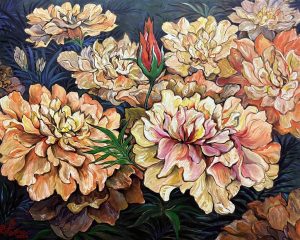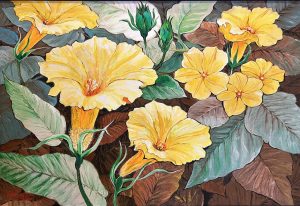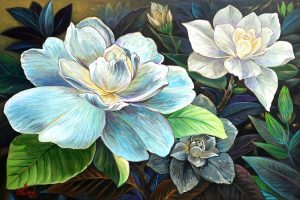The 1913 poem, Trees by Joyce Kilmer, wasn’t strictly about trees per se. Some studies mention that the poet’s trees symbolized people or nature. It was also a poem of praise to God, as Kilmer was a very prayerful man.
By that analogy, Roderick Sta. Ana’s florals are not paintings of the flowers themselves but actually inspired by certain people whether he personally knew them or as complete strangers.
Anthropomorphism in psychology terms is the attribution of human traits to non-human entities.
The artist’s professional background in the arts of stained-glass making, graphic design, culinary decoration, and illustration gave him the skills to use color, pose, gesture, and highly energized brush work in his art to express his thoughts on canvas. But skill is only a part of an artistic journey.
Imagine what it’s like to know someone. Or to watch strangers go by and picture them in your mind as flowers.
This is how the artist sees humanity. Each person’s traits are symbolized by a particular flower. And the character and emotion of that particular person is expressed through a burst of color and vivid brushstrokes. Flowers as wordless descriptions of the people the artist sees. Flowers as portraits of humankind.
A keen social observer, with a freedom of vision to see both the beautiful, and the ugly side of humanity with equal representation as toxic, delicate, colorful, pleasant, scented, and frail flowers.
If we see people as flowers then we must have a very optimistic outlook of life. Free of irony and self consciousness. Flowers as the most diplomatic and politically correct visual handle to describe The Good, The Bad and the Ugly.
Flowers as universally recognized and meaningful in all cultures transcends time, space, religion, race, and customs.
But without a clue as to the philosophy behind the paintings, we will never get a hold of the messages it carries. As always the case with creatives, we as outside observers, are left to figure it out on our own to find hidden gems of meaning behind paintings.





